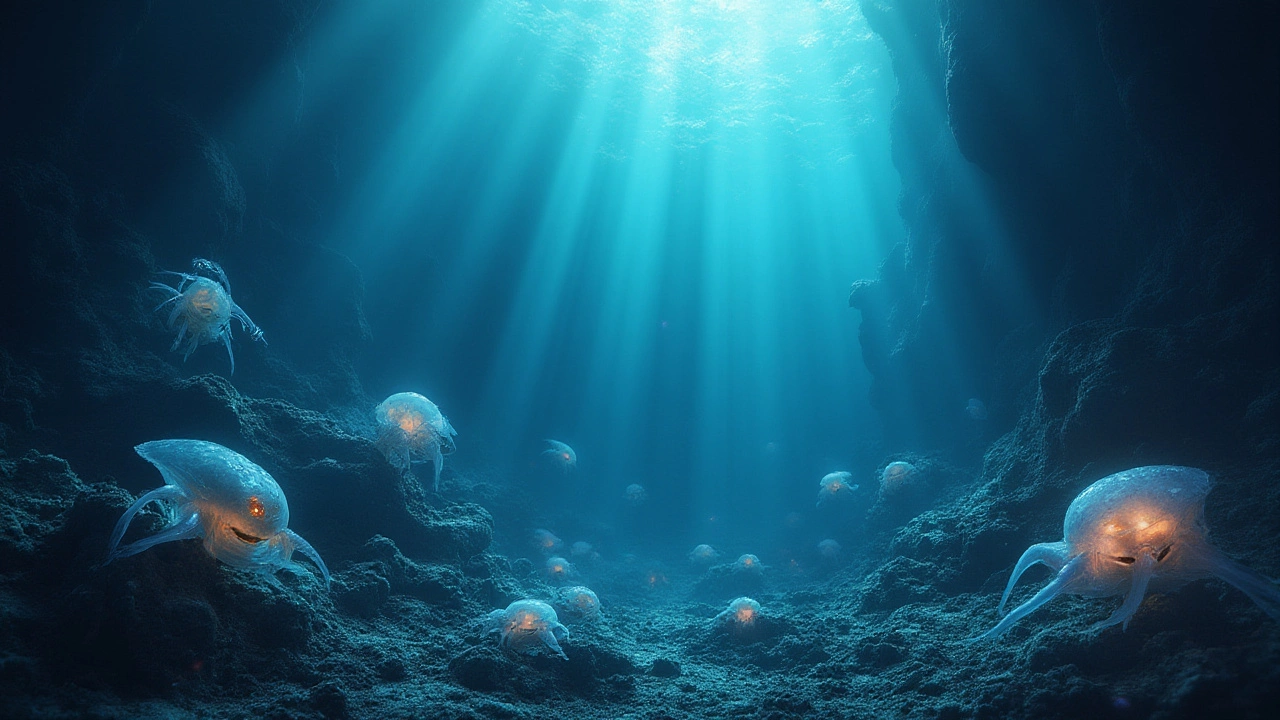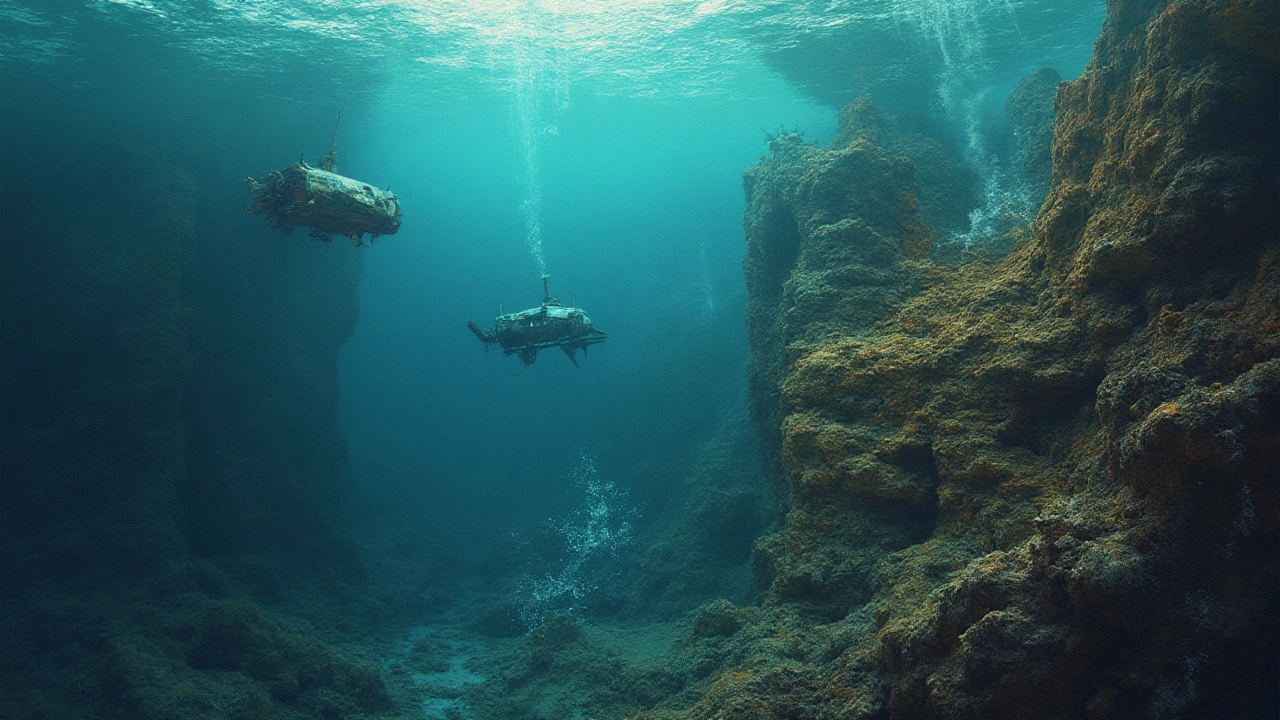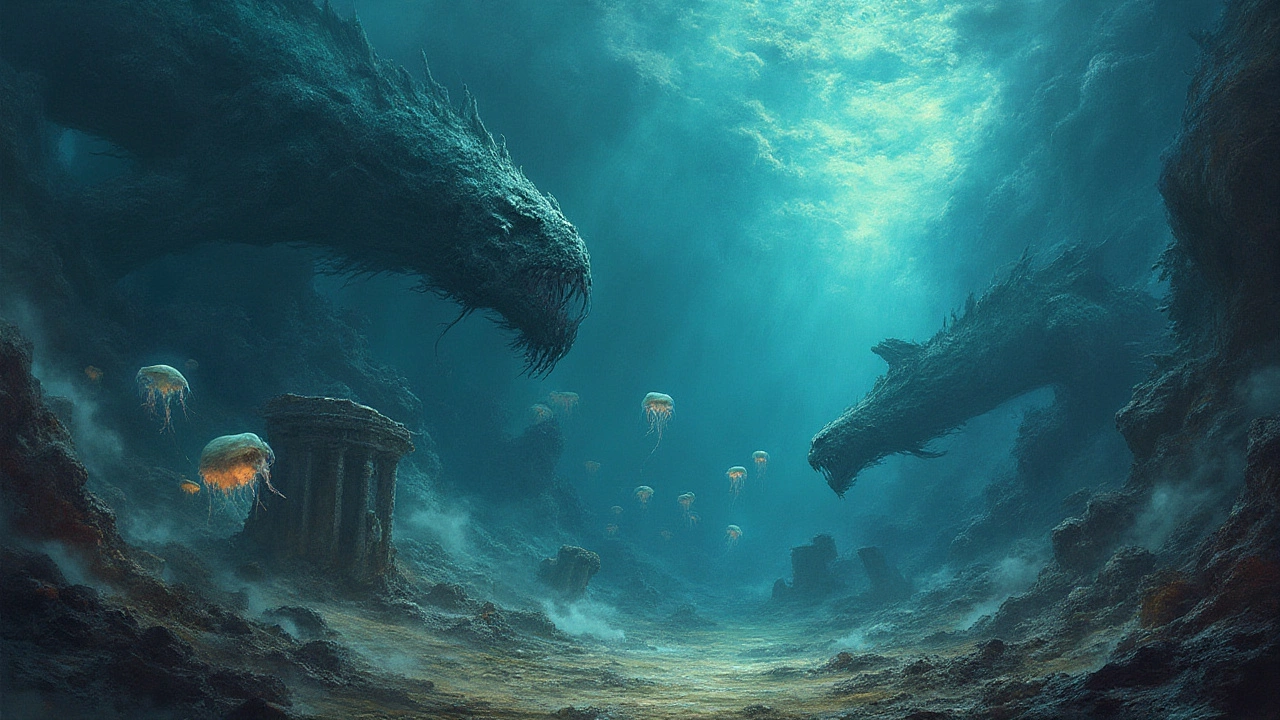What Lies Beneath the Mariana Trench: Deep Ocean Mysteries and Discoveries
 Jul, 22 2025
Jul, 22 2025
If you think Mount Everest is tall, flip that number upside down. The Mariana Trench is so deep, you could stack Everest in it—and still have more than a mile between the summit and the ocean surface. It’s mind-bending to imagine a place that’s plunged almost seven miles down, so dark and cold that sunlight is just a fairy tale. It’s easy to forget the planet even has these kinds of secret places. But that’s exactly what’s going on way out in the Western Pacific, where the trench runs more than 1,550 miles long and holds some of the wildest secrets anywhere on (or under) Earth.
Among the Darkest Depths: What the Trench Hides
Ask anyone what lurks in the Mariana Trench, and the guesses are bound to get wild. Giant squids? Prehistoric monsters? Lost cities? The reality is both stranger and more fascinating than most fiction. Down here, it’s pitch black—sunlight can’t even make a dent after about 1,000 meters, but the trench plunges over 11,000 meters at its deepest. Water pressure? Crushing. It’s more than 1,071 times what you feel at the surface. Imagine the weight of 50 jumbo jets stacked on your thumb. Temperature hovers just above freezing, often around 1 to 4°C. Yet, somehow, life found a way.
Every year, researchers send down advanced unmanned submersibles—like the remotely operated vehicle Nereus or the lander Deep Discoverer. Only a handful of human missions have visited Challenger Deep, the lowest point: Jacques Piccard and Don Walsh managed it in 1960, James Cameron achieved a solo descent in 2012, and Victor Vescovo went multiple times in 2019-2020. These dives are rare, risky, and expensive, pushing the limits of engineering just to catch a glimpse of what calls the deep home.
What have they found? Creatures straight out of science fiction, for starters. Take the amphipod Hirondellea gigas, a shrimp-like animal whose body produces special chemicals to scoop up scraps of organic matter and resist dissolving calcium at these toxic depths. Then there’s the ghostly snailfish—translucent, soft-bodied, and flabby, it floats through the extreme pressure with a body so thin it wouldn’t survive in a home aquarium. Scientists have also found giant single-cell organisms called xenophyophores, which can grow as large as tennis balls, and bacteria that thrive off nothing but the hydrogen and methane seeping from cracks in the Earth’s crust.
If you’re waiting for a sea monster, this place doesn’t disappoint with weirdness, even if it’s on a small scale. No evidence of Godzilla, but the trench does seem to have its own “alien” chemistry and lifeforms. DNA sampling from bottom sediments has found all sorts of unknown microbial species that eat what little is left—rotting fish, bits of plants, even plastic. Yes, researchers have discovered microplastics at the very bottom of the trench, reminding us that no corner of this world is untouched by humans anymore.
Check out what the trench has swallowed over the years in this quick comparison table:
| Item/Discovery | Depth (meters) | Date |
|---|---|---|
| Hirondellea gigas (Amphipod) | ~10,900 | 1950s-present |
| Snailfish (Pseudoliparis swirei) | ~8,000-8,200 | 2014 |
| Plastic bag fragment | 10,898 | 2018 |
| Challenger Deep Human Descent | 10,898 | 1960, 2012, 2019 |
One more oddity—sound travels differently here. Microphones dropped into the trench have picked up strange noises: clicks, pops, and a weird metallic “twang” whose source nobody’s been able to identify. Seismic activity is common, making this spot one of the least explored earthquake zones on the planet. It keeps you guessing if something big is hiding just out of frame.
But possibly the strangest fact is that we know more about Mars’ surface than what’s in the bottom of our own ocean trench. About 80% of the ocean floor is still unmapped, and even less of the trench is understood. That sense of mystery is part of what draws explorers back, again and again.

Scientists Versus the Abyss: Technology, Discoveries, and Limits
You’d think with today’s tech, we’d have charted the whole trench by now. Not even close. The crushing pressure and zero visibility make it a brutal place to work. Standard submarines would crumple like a tin can at these depths, so researchers use super-reinforced titanium vessels or robotic drones. But even those can be lost or crushed in seconds—Nereus imploded during a 2014 dive.
If you picture an underwater drone meandering around, it’s more like a tiny probe fighting for every foot. Sonar scans help build blurry 3D maps, while high-intensity lights and HD cameras grab rare photos. But anything left down there for long risks never coming back. Each mission costs millions, and recovering equipment from the deepest point on Earth is harder than landing something on the moon.
Let’s look at some of the tech that’s cracked the code:
- Bathyscaphe Trieste: The original beast, descending nearly 36,000 feet in 1960, held together by a sphere of specially thick steel. Its pilots saw nothing but shrimp and silt before heading home.
- DSV Limiting Factor: Victor Vescovo’s titanium submersible, used for multiple trips to Challenger Deep in the Five Deeps Expedition. Came equipped with cameras, robotic arms, and sensors to sample water and mud.
- Nereus: A remote-operated hybrid that switched between being a robot and a free-falling camera array. Captured rare video of amphipods and polychaete worms before disappearing into the deep forever.
With each run, scientists scoop up sediment and water samples, sample DNA, and hunt for anything that moves—or even just wiggles. They’re collecting data on how bacteria break down chemical energy, and how animals survive without bones made of calcium carbonate (it would just dissolve under these conditions). It’s like studying evolution in a pressure cooker. Some DNA sequences match nothing found elsewhere. Every trench mission adds new species—and in 2017, Japanese teams even found viruses no one had ever cataloged, wrapping up sponge-like particles as their "hosts."
What about the trench’s physical secrets? Its shape and odd “steps” were mapped by sonar, showing sharp drop-offs, hidden ridges, and a curved, arch-like rim. These aren’t just natural quirks. The whole trench was created by the Pacific Plate shoving itself underneath the smaller Mariana Plate, forming an ever-deepening pit that’s still getting deeper by centimeters a year. Watching the slow grinding of rocks down there informs everything from earthquake research to how our continents move.
Let’s break down what we know about living conditions at the very bottom:
| Condition | Challenger Deep | Explanation |
|---|---|---|
| Pressure | 1,071 bar / 15,750 psi | Crushes all but the toughest structures |
| Temperature | 1-4°C (33.8-39.2°F) | Just above freezing, no sun |
| Light | Zero, perpetual dark | Bioluminescence is only light source |
| Oxygen | Very low, but present | Bacteria and small scavengers cope |
| Salinity | Normal seawater | But chemistry affected by hydrothermal vents |
| Pollution | Plastics, toxic chemicals | Major surprise for scientists |
The more we discover, the more the trench seems like a window into the earliest days on Earth. Life here looks a lot like what we expect to find on frozen moons like Europa and Enceladus—hydrothermal vent creatures, bacteria eating hydrogen sulfide, and animals with bizarre metabolisms. Study this place closely enough, and you get a blueprint for what to look for if we ever poke a robot under the ice of Jupiter’s moons.
But the work isn’t just theoretical. Scientists are on alert for the next big impact—whether it’s finding a new chemical that can survive insane pressure or cracking the puzzle of deep-sea carbon cycling, which could tell us how climate change shifts ocean chemistry. The trench is a testbed for deep-sea mining technology, though that’s a hot debate: treasure for industry versus protecting the last wild corners of Earth. Every new sample means fierce arguments over patents, conservation, and the right to explore one of the world’s few genuine frontiers.

Secrets, Myths, and What Comes Next
For centuries, the Mariana Trench has spawned rumors. Sailors spun yarns of sea dragons and whirlpools swallowing ships. Some claimed the trench hid the lost city of Atlantis, or even a portal to another world. But the real secret is that this place is stranger than any myth—a cold, dark ecosystem that’s barely changed since before dinosaurs.
Here’s what’s been stirring up fresh buzz: Some marine biologists think the trench could be the key to finding medicines that work in high-pressure or cold environments—enzymes that don’t break down in a standard lab, for instance. There’s also talk about whether building blocks for life on land originally came from bacteria that lived deep in places just like this. It doesn’t hurt that every few years, unstoppable explorers find a new super-odd fish or a shrimp with “antifreeze” proteins that let it swim in mud at insane pressures.
Ever wonder who owns the trench? Technically, it sits in international waters, with nearby Guam holding partial jurisdiction. But the seabed and whatever is living in it? That’s a gray area. With new deep-mining interests popping up, there’s worry about corrupting the last untouched habitats. Giant corporations aren’t mining down here yet—not for lack of trying—but many researchers want protections in place, like an underwater national park.
You’ve probably noticed that anything from the trench looks downright alien. The creatures here don’t have eyes (what’s the point?), most are pale, and many glow with neon blue or green when startled. That light isn’t just for show; it’s usually a warning or a lure in the never-ending “eat or be eaten” contest happening in the mud.
And as much as the trench tells us about the past, it’s shaping the future too. With technology evolving, private companies (like Triton Submarines) and billionaire adventurers are now pushing for recreational deep-sea tourism. Sounds crazy, but if safety keeps improving, seeing the trench could someday be as routine as climbing Everest. Just don’t expect reception for your smartphone.
If you’re itching to find out more, here are a few practical tips:
- Follow updates from the Schmidt Ocean Institute and NOAA; their teams livestream dives when they can.
- To support science over commercial mining, check out organizations like the Deep Sea Conservation Coalition.
- If you’re a student, tons of data from trench missions is open-access—try analyzing it for your own school or science projects.
The race to learn more about what’s hidden in the Mariana Trench is just getting started. Who knows—maybe the biggest surprise is still waiting, buried in the mud or drifting through the deep. If you ever want to feel small, just remember the planet’s true heart doesn’t beat on a mountaintop, but miles beneath the waves, where every answer leads to more questions.